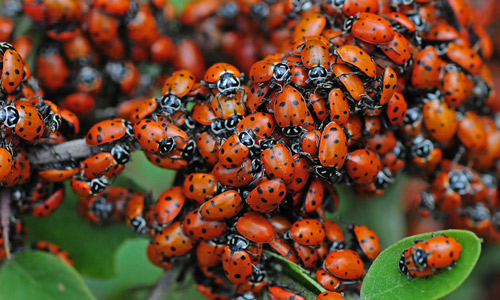The Convergent Lady Beetle, 'Bug of the Week' post from Cooperative Extension Service's Integrated Pest Management Program
Bug of the Week 5/18/2023
This week’s bug of the week is the lady beetle, Hippodamia convergens. If you’ve ever looked into buying lady beetles as a biocontrol, this is probably the species sold. About this time every year I see a post, or am asked about using lady beetles for controlling aphids and such in the garden. And, I suppose every year I may make a post about why you should not. To begin with, this species is not native to Alaska. So, purchasing them and releasing them is really introducing a non-native species. Like the Boa in Florida, or pigs in Texas, they can become a real problem. The second is they are not reared. They are collected in the wild where the species aggregates to ride out the winter. People just come along and take thousands from their winter sleep to sell. This has decimated population in their native range in the Sierra Nevada. Could you imagine going and taking thousands of Monarch butterflies from the trees in Mexico? Many of the online “sellers”, even on Amazon, are not reputable agents and lack proper business licenses or permitting to sell to Alaska.
My other reason is they don’t work. Being that they were taken from their period of torpor, they first want to feed for a week or two, then migrate. Some will be sold as already fed, so they really just want to leave. This is one reason why they don’t work. If you release them in a garden they will leave. If you contain them in a greenhouse, they will feed for a few days, then try to migrate, then lay eggs. Then you have to wait for the eggs to hatch, and the larva to grow. So, the only impact they will make is when the adults feed that first week and then when the larger larva feed a few weeks later. Add to this they are not all that impactful when they do stay around. Studies have found much higher concentrations are needed than what suppliers recommend to be effective. In the greenhouse 200-350 beetles are needed per plant for noticeable aphid control. In the outdoors, try 2000 per plant. So, if you have 10 Dahlia you’re trying to protect from thrips, that’s a $500 gamble. Whereas cheap and reliable cultural or synthetic options are much, much cheaper. There are other reasons, like competing or introducing pathogens to our native lady beetle fauna which are also good reasons. Really, it’s just not a good idea, regardless of what the Facebook says.
Joey Slowik, IPM Technician
jaslowik@alaska.edu
You can submit unknown pests (plants, insects, diseases, etc.) through the UAF Citizen Scientists Monitoring Portal: www.alaskapestreporter.org

Photo: Mass of convergent lady beetles in Alamo Peak, Otero Co., NM. Photograph by Jerry Oldenettel.









